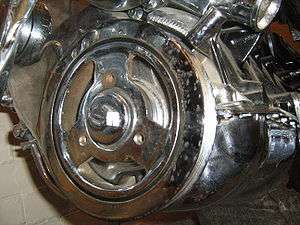Harmonic balancer

A harmonic balancer (also called crank pulley damper, crankshaft damper, torsional damper, or vibration damper) is a device connected to the crankshaft of an engine to reduce torsional vibration and serves as a pulley for drive belts.[1]
Vibration
Every time the cylinders fire, torque is imparted to the crankshaft. The crankshaft deflects under this torque, which sets up vibrations when the torque is released. At certain engine speeds the torques imparted by the cylinders are in sync with the vibrations in the crankshaft, which results in a phenomenon called resonance. This resonance causes stress beyond what the crankshaft can withstand, resulting in crankshaft failure.
Countering vibration
To prevent this vibration, a harmonic balancer is attached to the front part of the crankshaft. The damper is composed of two elements: a mass and an energy dissipating element. The mass resists the acceleration of the vibration and the energy dissipating (rubber/clutch/fluid) element absorbs the vibrations.
Additionally the energy transferred from the piston to the crankshaft can induce as much as 2 degrees of twist in the crankshaft, which has many follow-on effects on all engine elements that require adequate timing such as valve opening, cam timing, ignition timing etc.
Maintenance
Over time, the energy dissipating (rubber/clutch/fluid) element can deteriorate from age, heat, cold, or exposure to oil or chemicals. Unless rebuilt or replaced, this can cause the crankshaft to develop cracks, resulting in crankshaft failure.
Effects of removal
Performance enthusiasts have been known to remove harmonic balancers, usually when the balancer is attached to the crank pulley, deciding that they aren't necessary and their mass reduces the performance of the engine. However, this is unproven and potentially very risky because the danger of damage to the engine from the vibrations the damper is intended to prevent is too high.
Certain cars, however, do not come equipped with an external balancer on the crank pulley, and as such, can have the pulley replaced with a performance oriented product which counter-acts these resonance frequencies.
See also
References
- Inline
- ↑ "Car Talk", March 2000, retrieved on 2009-12-10.
- General
- http://www.moparmusclemagazine.com/techarticles/engine/mopp_081027_crankshaft_damper/index.html
- http://www.atiracing.com/products/dampers/sae.htm